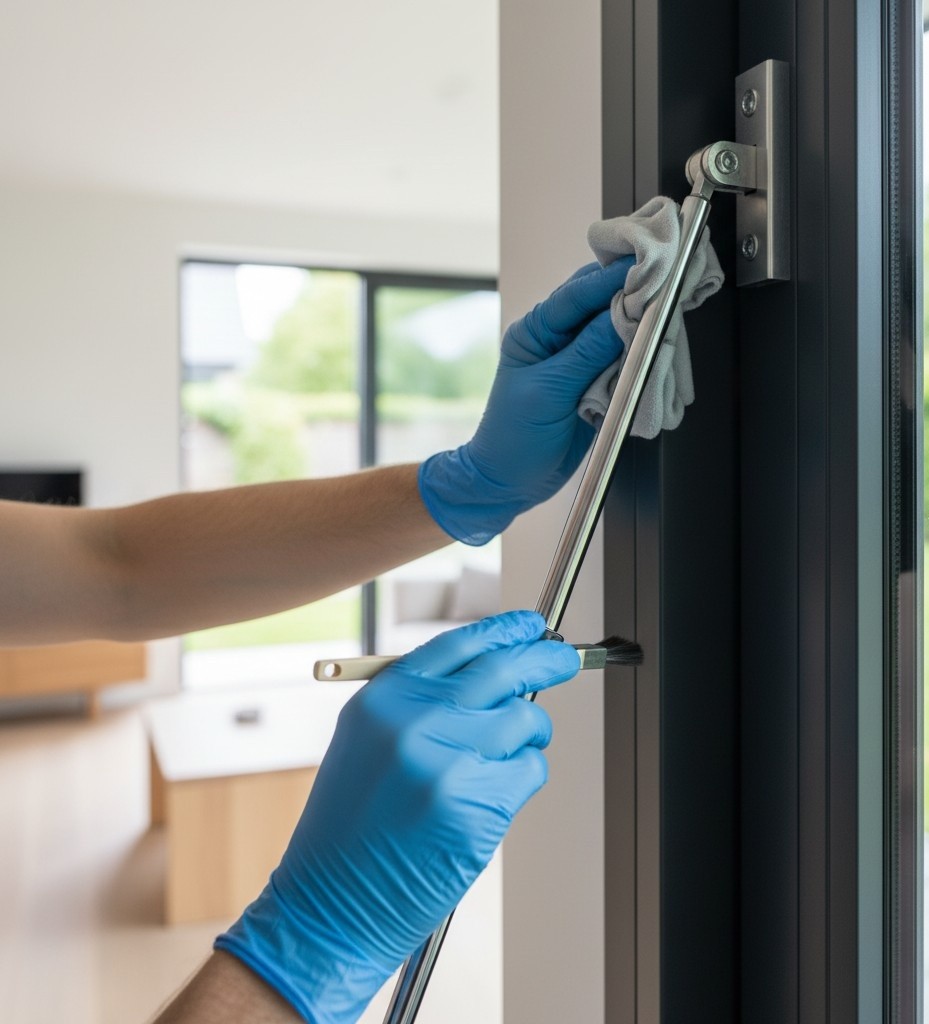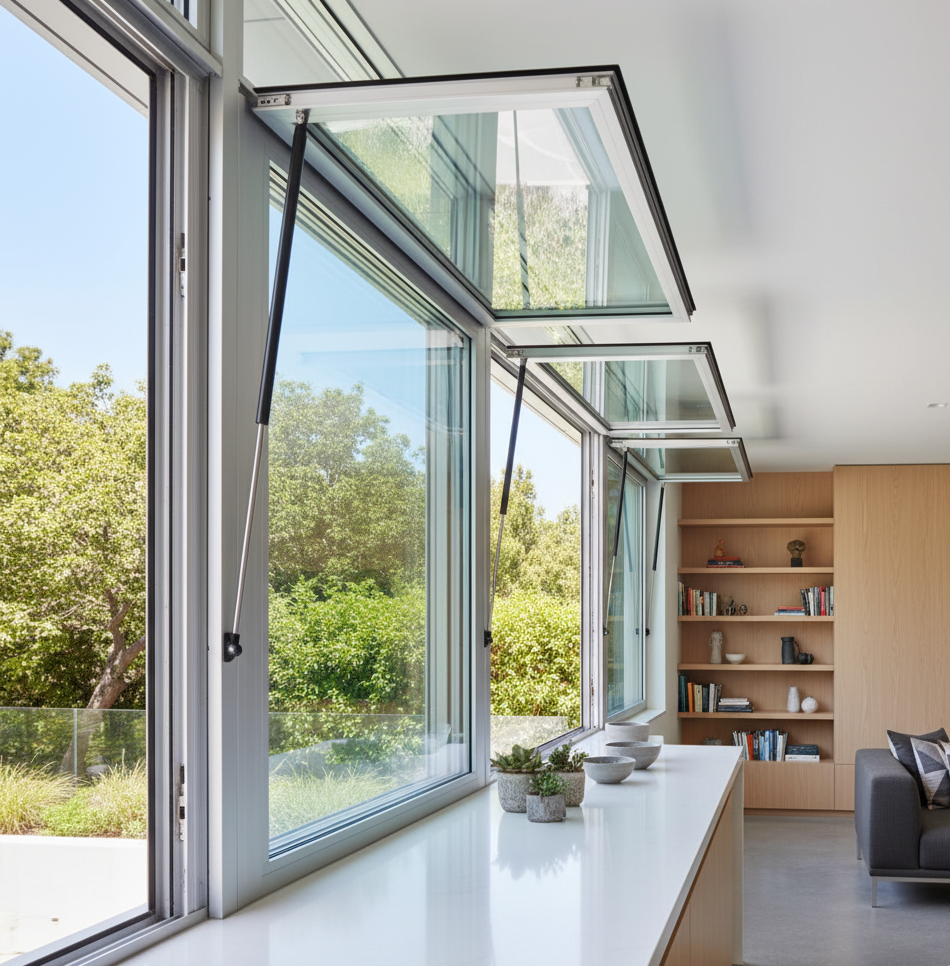You push open a window expecting fresh air, but instead it hesitates, creaks, and drops back too quickly. It feels small at first, but those little signs often point to gas struts losing pressure and hardware beginning to fail. Left unchecked, what should be a seamless experience can quickly turn into a safety risk and an expensive fix.
Gas strut windows are built for elegance and ease, but like any precision system, they demand care. With the right maintenance, their smooth lift and balanced hold can last for years. This guide breaks down how to clean, inspect, and replace key components to keep them performing at their best.
Key Takeaways:
- Gas strut windows require routine cleaning, inspections, and replacements to maintain safety, performance, and longevity.
- Weak or damaged struts risk sudden closure, causing hazards and costly repairs if left unaddressed.
- Proper care includes cleaning glass, frames, seals, and tracks while avoiding solvents or lubricants on struts.
- Regular inspections detect leaks, rust, jerky motion, or closure issues, signaling when struts need prompt replacement.
Why Gas Strut Window Maintenance Is Essential
Maintaining gas strut windows is not only about appearance; it directly impacts performance, safety, and cost. Regular attention reduces the risk of sudden failure, extends lifespan, and preserves the value of the investment.
Key Benefits of Maintenance
- Safety
Weak or damaged struts can cause sudden window closures, creating hazards for users and property. - Effortless Operation
Clean tracks, functioning struts, and secure hardware ensure smooth, reliable movement. - Longevity
With consistent care, struts and seals can last for years. Neglect accelerates wear and tear. - Cost Savings
Detecting early issues such as sluggish or jerky motion prevents expensive replacements. - Consistent Performance
Properly maintained struts preserve pressure and seal integrity, making gas strut windows for outdoor living stable and efficient
Cleaning and Care Tasks
Keeping components clean reduces friction, prevents buildup, and preserves energy efficiency.
1. Window Glass
- Wash with mild detergent diluted in water.
- Avoid cleaning in direct sunlight to reduce streaking.
- Wipe with a lint-free cloth or microfiber towel.
2. Frames & Seals
- Clean using warm soapy water and a soft brush.
- Use diluted vinegar for aluminum frames with stubborn stains.
- Rinse thoroughly to remove residue.
3. Weatherstripping
- Gently wipe with a damp cloth.
- Avoid solvents or harsh cleaners that weaken elasticity.
4. Tracks
- Vacuum dust, dirt, and debris regularly.
- Lightly apply silicone spray for smooth operation.
Gas Strut Maintenance and Safety
Gas struts are precision-engineered components under high pressure, and their care directly affects safety and reliability.
Cleaning and Handling
- Wipe regularly: Clean the piston rod with a dry, lint-free cloth to prevent dust buildup.
- Store and mount correctly: Always position gas struts with the piston rod pointing downward. This keeps seals lubricated and prevents premature wear.
- Operate gently: Avoid slamming or forcing the window, which stresses the struts.
What to Avoid
- Do not grip or scratch the piston rod: Damage compromises seals and leads to leaks.
- Avoid external lubricants or solvents: These break down seals and attract dirt.
- Do not paint struts: Paint can stick to the rod and damage seals during operation.
- Protect from heat and punctures: As sealed pressure vessels, struts can rupture if pierced or overheated.
Inspection and Replacement
- Check for leaks or rust: Oil stains, dents, or corrosion signal a failing strut.
- Test window performance: If it no longer holds open or moves unevenly, pressure may be lost.
- Replace promptly: Swap out damaged struts immediately—preferably in pairs for balance.
Safety Precautions
- Wear protective gear: Gloves and safety glasses reduce risk when handling struts.
- Use proper tools: Some models require special clips or mounting aids.
- Seek professional installation for large projects: Heavy or multiple strut installations should be handled by trained technicians.
Quick Reference: Do’s and Don’ts of Gas Strut Care
|
Do’s |
Don’ts |
| Wipe struts clean with a soft cloth | Apply grease, oil, or solvents |
| Store with piston rod pointing down | Scratch, grip, or paint the piston rod |
| Inspect for leaks and corrosion | Expose to extreme heat or puncture |
| Replace faulty struts promptly | Attempt removal without proper support |
Frame & Hardware Inspection
Regular inspection ensures the entire system stays secure and weather-tight.

Hardware Tightness
- Tighten screws, hinges, and brackets every six months.
- Loose fittings put strain on the frame and struts.
Seal & Caulk Integrity
- Inspect caulking for cracks or gaps.
- Replace deteriorated sealant to block water and air leaks.
Water Damage Detection
- Look for swelling, discoloration, or mold near the frame.
- Keep weep holes clear for proper drainage.
Frame & Seal Care Schedule
|
Task |
Frequency |
Tools Needed |
| Tighten hardware | Every 6 months | Screwdriver, wrench |
| Inspect caulk & seals | Every 6 months | Utility knife, sealant |
| Clean weep holes | Quarterly | Small brush, water |
Identifying Signs of Strut Failure
Gas struts degrade naturally. Early recognition prevents accidents and costly downtime.
- Slower Movement – Window opens with more effort.
- Jerky Motion – Inconsistent or shaky performance.
- Sudden Closure – Window fails to stay open.
- Hissing or Leaks – Gas escaping from the cylinder.
- Rust or Dents – Visible damage affecting reliability.
Replacement Process
When a strut is no longer functional, timely replacement restores performance.
Step 1: Preparation
- Select the correct strut size, pressure rating, and type.
- Arrange support for heavy or large windows.
Step 2: Detach Old Strut
- Secure the sash before removal.
- Release clips and carefully disconnect the strut.
Step 3: Install New Strut
- Align fittings and snap into place.
- Confirm locking clips are secured.
Step 4: Test Operation
- Open and close the window several times.
- Check for smooth and balanced movement.
Replacement: DIY vs. Professional Service
| Aspect | DIY Replacement |
Professional Service |
| Cost | Lower upfront | Higher initial cost |
| Skill Level | Requires basic tools | Expert installation |
| Risk | Incorrect fit or damage | Minimal risk |
| Best For | Single window units | Bulk projects, large frames |
After completing the basic replacement steps, professionals often turn to comprehensive installation guides on gas strut flip-up windows for finer alignment and safety details.
Professional Support and Industry Considerations
For most day-to-day care, routine cleaning and inspections can be managed on-site. However, when it comes to replacement parts, large-scale projects, or ensuring system longevity, professional support becomes valuable.
When to Seek Professional Help
- Complex installations: Large or heavy windows often require trained technicians for safe strut replacement and calibration.
- Bulk projects: Builders and wholesalers managing multiple units benefit from standardized parts and consistent installation practices.
- Compliance requirements: Commercial projects may require products that meet international certifications and quality standards.
Role of Trusted Manufacturers
Working with established window and door manufacturers ensures that struts, frames, and seals are engineered for durability and long-term reliability. Global suppliers often provide:
- Custom-engineered solutions to match specific architectural designs.
- Certification-backed products that comply with residential and commercial codes.
- Scalable production capabilities suitable for distributors and developers.
As an example, Oridow, a China-based aluminum windows and doors manufacturer, specializes in delivering certified, customizable fenestration systems for global projects. Their approach reflects the level of technical support and system expertise professionals should look for when sourcing reliable solutions.
Conclusion
Gas strut windows combine aesthetics with performance, but they require care to remain safe and efficient. Cleaning glass, frames, and seals, maintaining tracks, and properly handling gas struts ensures reliable operation for years. Regular inspections and timely replacements reduce risks, control costs, and extend window life.
For builders, wholesalers, and architects, partnering with certified suppliers ensures that every project benefits from reliable performance and long-term value. With proactive maintenance and professional support, gas strut windows remain a strong investment in modern design and functionality.
1. How often should I maintain my gas strut windows?
Gas strut windows benefit from both routine cleaning and scheduled inspections. Light cleaning can be done monthly, while full inspections should happen at least twice a year to ensure struts, seals, and hardware remain in good condition.
- Light cleaning: once a month
- Track vacuuming: every 2–3 months
- Full inspection: every 6 months
- Professional check (if needed): annually
2. What are the signs that a gas strut is failing?
When a strut starts to lose pressure or sustain damage, the window will show noticeable performance issues. Recognizing these early prevents sudden failures.
- Window opens sluggishly or feels heavy
- Jerky or uneven movement when lifting
- Window won’t stay open and closes abruptly
- Hissing sounds or visible oil leakage
- Rust, dents, or corrosion on the cylinder
3. Can I lubricate my gas struts to improve performance?
No. Gas struts are pre-lubricated internally and should never be oiled or greased. External lubricants can attract dirt and damage seals. Instead, focus on keeping them clean and free from debris.
- Wipe with a dry, lint-free cloth
- Avoid solvents, grease, or oil
- Keep piston rods free from scratches or paint
4. How do I safely clean the frames and seals?
Frames and seals require gentle cleaning to preserve durability and weather resistance. Using the right cleaning solutions prevents corrosion and prolongs effectiveness.
- Use warm soapy water with a soft cloth or brush
- For aluminum, apply diluted vinegar to remove stains
- Rinse thoroughly to remove residue
- Inspect seals for cracks while cleaning
5. When should I replace my gas struts?
Struts should be replaced when they no longer hold the window open securely or show visible damage. Replacing them promptly ensures safety and consistent function.
- Window won’t stay open
- Sluggish or uneven performance
- Oil leaks or hissing noises
- Visible dents, rust, or wear
- Every 5–7 years on average, depending on use
6. Can I replace gas struts myself, or should I hire a professional?
Smaller windows with standard fittings can often be managed as a DIY task, but large or heavy units require professional expertise. Incorrect installation can compromise safety.
- DIY is suitable for small, lightweight windows
- Professionals recommended for large or bulk projects
- Always use the correct replacement strut model
- Support the sash securely during replacement
7. How do I prevent water damage around my gas strut windows?
Water damage is usually caused by clogged weep holes or failed seals. Keeping drainage channels clear and checking caulking prevents leaks and structural issues.
- Clean weep holes quarterly with a small brush
- Inspect and replace cracked caulk around the frame
- Check for staining, mold, or swelling around frames
- Schedule routine inspections during rainy seasons





